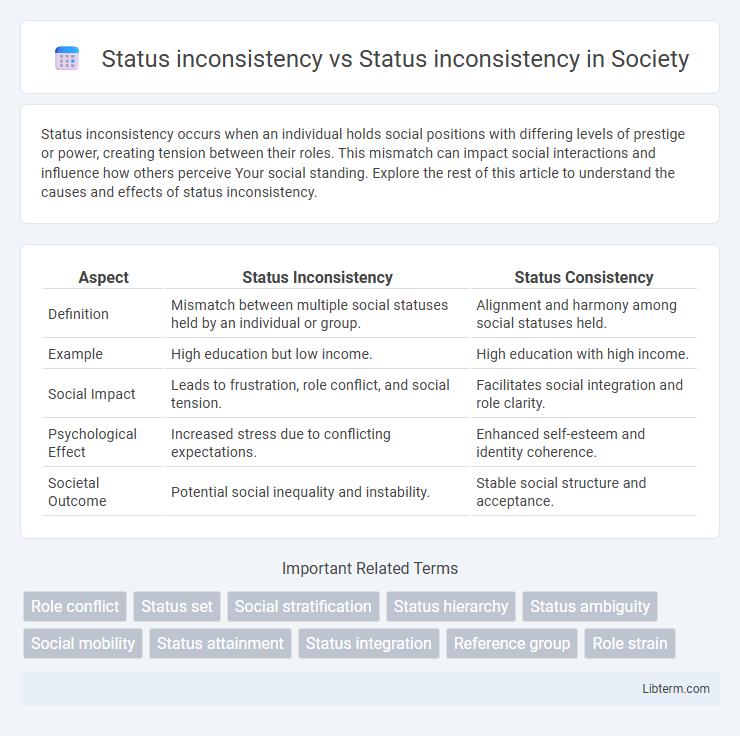Status inconsistency occurs when an individual holds social positions with differing levels of prestige or power, creating tension between their roles. This mismatch can impact social interactions and influence how others perceive Your social standing. Explore the rest of this article to understand the causes and effects of status inconsistency.
Table of Comparison
| Aspect | Status Inconsistency | Status Consistency |
|---|---|---|
| Definition | Mismatch between multiple social statuses held by an individual or group. | Alignment and harmony among social statuses held. |
| Example | High education but low income. | High education with high income. |
| Social Impact | Leads to frustration, role conflict, and social tension. | Facilitates social integration and role clarity. |
| Psychological Effect | Increased stress due to conflicting expectations. | Enhanced self-esteem and identity coherence. |
| Societal Outcome | Potential social inequality and instability. | Stable social structure and acceptance. |
Defining Status Consistency and Status Inconsistency
Status consistency occurs when an individual's social positions align across various dimensions such as occupation, education, and income, creating a cohesive social identity. In contrast, status inconsistency arises when an individual's social ranks are uneven, for example, possessing high education but low income, leading to potential social tension or identity conflicts. Understanding the nuances of status consistency and inconsistency is crucial for analyzing social mobility and stratification dynamics.
Historical Perspectives on Status Inconsistency
Historical perspectives on status inconsistency emphasize early sociological theories by Max Weber, who identified the contradictions arising when individuals hold differing positions across social hierarchies such as wealth, prestige, and power. Subsequent research expanded on these concepts by examining the psychological and social tensions resulting from mismatched statuses in modern stratified societies. This foundational framework remains critical for understanding the complexities of social mobility and inequality today.
Key Sociological Theories Explaining Status Inconsistency
Key sociological theories explaining status inconsistency primarily include Max Weber's multidimensional approach to social stratification, which emphasizes the divergence between different status dimensions like class, status, and party. Talcott Parsons viewed status inconsistency as a source of role strain, affecting social integration and individual behavior within societal systems. Pierre Bourdieu expanded the concept with his theory of social capital, where discrepancies between economic, cultural, and social capital lead to varied social status experiences and inconsistencies.
Examples of Status Inconsistency in Modern Society
Status inconsistency occurs when an individual's social positions have both high and low rankings across different status dimensions, such as education, income, or occupation. For example, a highly educated professional working a low-wage job or a wealthy individual lacking formal education illustrates this inconsistency. Modern society frequently witnesses status inconsistency in gig economy workers, who may possess advanced skills but receive irregular income and job insecurity.
Measuring Status Consistency and Inconsistency
Measuring status consistency involves evaluating the alignment between an individual's various social statuses, such as occupation, education, and income, using quantitative indices like Duncan's Socioeconomic Index or status prestige scales. Status inconsistency is identified through disparities or conflicts among these statuses, often assessed by analyzing discrepancies between expected and actual social rankings or using methods like the composite status inconsistency score. Accurate measurement of status (in)consistency relies on multi-dimensional data capturing occupational prestige, educational attainment, and income levels to reveal the extent of congruence or divergence within an individual's social positioning.
Social and Psychological Impacts of Status Inconsistency
Status inconsistency occurs when an individual's social positions have both high and low rankings across different status dimensions, such as income, education, and occupation, leading to conflicting social signals. This inconsistency generates psychological stress and feelings of frustration due to the mismatch between societal expectations and personal identity. Socially, status inconsistency can cause tension in interactions and reduce social cohesion, as individuals struggle to navigate conflicting perceptions and recognition within their social networks.
Status Inconsistency in the Workplace: Challenges and Outcomes
Status inconsistency in the workplace occurs when individuals experience conflicting social positions, such as high professional expertise paired with low organizational rank, creating role ambiguity and stress. This discordance can result in decreased job satisfaction, impaired performance, and increased turnover intentions due to perceived unfairness and identity tension. Organizations addressing status inconsistency often observe improvements in employee engagement and productivity by fostering clearer role definitions and equitable recognition systems.
Status Consistency vs. Status Inconsistency: Comparative Analysis
Status consistency refers to the alignment between an individual's social positions, such as occupation, education, and income, which typically results in predictable social behavior and smoother role performance. Status inconsistency occurs when an individual's social positions have conflicting status levels, causing tensions and challenges in identity and social interactions. Comparative analysis reveals that status consistency fosters social stability and higher life satisfaction, whereas status inconsistency can generate social strain but may also motivate social mobility and adaptive strategies.
Addressing Status Inconsistency: Solutions and Interventions
Addressing status inconsistency involves targeted interventions such as educational programs, workplace diversity initiatives, and social support systems designed to reduce conflicts arising from mismatched social statuses in occupation, income, and education. Implementing equitable policies that promote social mobility and inclusive environments helps mitigate the negative psychological and social effects related to status inconsistency. Empirical studies indicate that tailored community engagement and organizational reforms significantly improve individual well-being and occupational satisfaction by harmonizing divergent status positions.
Future Research Directions on Status Consistency and Inconsistency
Future research on status consistency and inconsistency should explore the dynamic interplay between individual social identities and structural factors across diverse contexts. Emphasizing longitudinal studies can reveal how shifts in occupational prestige, education, and income contribute to changes in status inconsistency over time. Integrating neurocognitive and sociocultural methodologies will enhance understanding of how status perceptions impact health, behavior, and social mobility.
Status inconsistency Infographic

 libterm.com
libterm.com